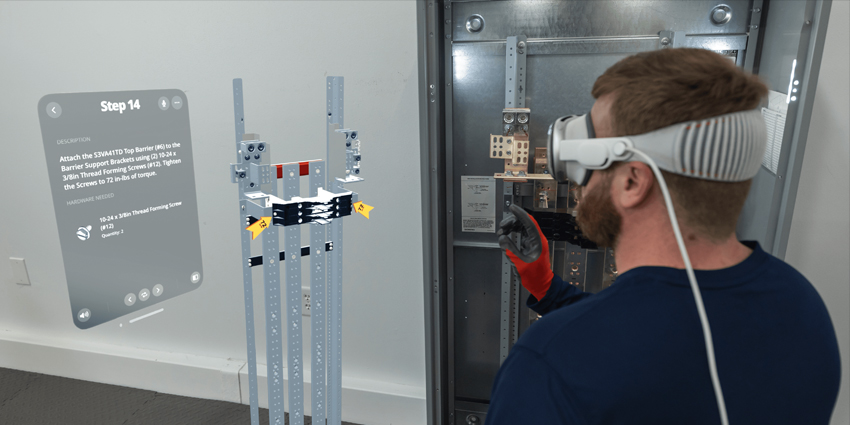For Metaverse and XR fans, the full-body avatar has long seemed like a distant dream. Through the years, even the most innovative metaverse companies have struggled to provide users with fully realistic avatars.
For the most part, your digital identity on channels like Microsoft Teams and Zoom is likely to consist of a face and a set of shoulders. However, some companies have implemented hand-tracking to convey arm movements in digital landscapes, too.
But things are starting to change as the avatar’s role in the metaverse becomes more essential, particularly for companies investing in meta-work, immersive collaboration, and XR innovation. The concept of the full-body avatar is finally gaining legs (literally) in a handful of environments.
The question is, what makes a full-body avatar so much more appealing? Why do we need more realistic, human, and complete avatars? And how exactly can professionals create full-body avatars to traverse the metaverse?
The Rise of the Full-Body Avatar
The avatar is probably one of the most exciting components of any “metaverse” experience. It’s essentially a virtual representation of a human being implemented into a digital space. Avatars allow us to express ourselves, form deeper connections, and interact with digital content.
In today’s business world, realistic avatars don’t just help employees to collaborate more effectively with colleagues. The right avatar can help brands gain customers’ trust and deliver more memorable experiences.
Unfortunately, creating a full-body avatar that accurately conveys every aspect of your “physical presence” in the metaverse isn’t easy. While technologies are emerging to make avatars more unique and realistic, many companies have avoided the “full body” route.
Most metaverse platforms allow users to customize an avatar with a head, face, and sometimes hands that can react to their real-life actions. Hand and eye tracking technologies make it easier to monitor these components of our bodies and translate them into digital behaviours.
Without new sensors or haptic feedback tools, tracking things like torsos and legs is complex. A full-body avatar is technically challenging, particularly if users expect their legs and bodies to move naturally in virtual environments.
A virtual body that moves awkwardly could be more off-putting than an avatar with no legs. Plus, there are social and cultural issues that developers must also consider. For instance, how secure and safe will we feel if our entire identity is transferred into the metaverse?
The Evolution of Avatars: Creating Virtual Personas with Legs
Meta recently announced that future avatars for its metaverse environments, like “Horizon Worlds,” will have their own trackable legs.
But it’s taken quite a while for Meta to reach this point. Back in 2022, around 1 year after Horizon Worlds was initially released, Meta introduced us to the first version of its digital avatars. CEO Mark Zuckerberg even posted a selfie from Horizon Worlds – but the response wasn’t great.
The legless, relatively ugly avatar left customers wondering about the quality of the Meta team’s ” metaverse environment. ” Consumer backlash was so significant that Zuckerberg immediately jumped to action to announce that avatars would get a major update.
In October 2022, Zuckerberg showed off its new full-body avatar solution with working legs and feet. At the Meta Connect event, the Meta CEO shared that legs were probably the “most requested” feature on their roadmap. But he also explained that legs were notoriously tricky.
According to Zuckerberg, it’s tough for a VR headset to estimate where various parts of your body are accurately. With its developments in the XR space, Meta has become more effective at tracking body parts. However, it only recently developed an AI model capable of predicting the position of your entire body.
Unfortunately, while avatar legs are set to arrive on the Meta Horizon platform, there’s no information yet about when they’ll be fully available. Beta testers have already revealed some insights indicating the entire body avatar might not be as impressive as it seems.
For instance, you can only see your legs when you look at an in-game mirror (though other people will be able to see them). Plus, avatars can’t crouch or jump in extended reality even with AI-driven insights.
The Benefits of the Full Body Avatar for Business XR
So, why bother with a full-body avatar at all? With industry leaders like Meta still struggling to get legs right, can anyone master the challenge?
However, while there are a number of challenges to overcome, more realistic, complete avatars could deliver many benefits, particularly to businesses. Moreover, with new evolutions in face, eye, and body tracking emerging every day, we may soon enter a world where creating a full-body avatar isn’t as complex as it seems.
Probably the biggest advantage a full-body avatar offers is a greater sense of immersion in the metaverse. Metaverse environments are designed to help us explore and experience environments beyond the restrictions of physical landscapes.
It’s hard to feel fully present in a space if only your hands and face are visible. But there are other benefits too, such as:
Improved Collaboration
Improved collaboration is one of the primary use cases for both metaverse technologies and XR in the business landscape. Virtual landscapes offer an opportunity to unify employees in a shared space, wherever they are.
Companies can create digital twins of office spaces, provide comprehensive access to virtual versions of tools and resources, and create opportunities for unbridled creativity. But to collaborate with others effectively, we need to feel connected to them or at least sense their “presence” in an environment.
A full-body avatar could improve that sense of presence, helping employees connect in a more human, engaging format in virtual worlds. In cases where avatars can move around and perform human gestures, body language can even help to boost the quality of communication.
After all, body language is a massive part of the communication process, helping to reduce misunderstandings and bring context to conversations.
A Better Brand Image
Increasingly, companies are investing in extended reality tools to upgrade and enhance their customer service strategies. With virtual reality, companies can create metaverse stores and shops or virtual onboarding and training experiences for new customers.
Using augmented and mixed reality, businesses can distribute virtual versions of team members to customers wherever they are. These avatars can guide, troubleshoot problems, and answer real-time questions.
The more realistic and complete a metaverse avatar is, the more likely it is to reflect positively on the brand. High-quality avatars can more effectively represent a brand in digital settings. More human avatars can even put customers at ease in specific industries, helping to build trust between clients and employees in the financial, legal, or healthcare space.
One study even found a consistent metaverse avatar made customers more likely to trust the company they were working with and spend more on their products.
Better Expression and Inclusivity
One of the main reasons avatars are so valuable in the XR landscape is they allow users to express themselves in a virtual landscape. Employees and consumers alike want to be able to create realistic versions of themselves to traverse digital landscapes.
The more companies empower employees with avatars that reflect their unique appearance, the more likely they are to feel respected and “included” in the workplace. Indeed, as concerns around diversity and equality in the metaverse continue to emerge, many companies offering their own “full body avatar creators” are introducing endless new skin tones, eye colours, and accessories.
Freedom of expression doesn’t just make team members feel more connected in the virtual workspace; it can also help to increase confidence. One study found that avatars can allow users typically reluctant to speak up in real life to participate in more experiences.
Enhanced Training Experiences
Countless studies have already drawn attention to the potential of extended reality and the metaverse for enhancing training initiatives. These technologies can help people retain more information and develop new muscle memories by offering access to experiential simulations.
While many forms of extended reality training have already proven successful, introducing the full body avatar could take initiatives a step further. One study allowed trainees to use both full-body and partial avatars in a training session to assess their results.
The results found that participants were more likely to feel fully immersed in the situation and even truly perceive threats when using a full-body avatar. The researchers concluded that a full-body avatar could improve educational outcomes in various environments, including police training scenarios.
Greater Engagement
By improving a user’s sense of presence in a virtual space, a full-body avatar could create higher levels of engagement. Countless companies are already struggling to preserve engagement in a world of hybrid and remote work.
When isolated from a traditional business environment, many employees feel disconnected and unable to connect with their colleagues and the content provided to them. Even video conferencing platforms don’t necessarily guarantee a high level of engagement.
However, providing employees with a fully immersive experience where they can fully “embed” themselves into a digital space is another story entirely. Full-body avatars could help reduce distractions and disengagement in the workplace, leading to higher productivity levels.
How to Create a Full-Body Avatar
So, how can employees create a full-body avatar they can send into the metaverse? Right now, the options are a little limited. As mentioned, few companies are experimenting with true “full body avatars” that can replicate human movement.
But there are a few options, even without waiting for Meta to perfect its avatars. For instance, Spatial, the VR platform for artists, now offers a full-body avatar option within its app. It allows users to bring avatars from “Ready Player Me” to their virtual worlds.
Ready Player Me uses photos to create realistic-looking full-body avatars for games, with hundreds of customization options. When designing, you can even choose your body type, height, and other characteristics.
Outside of Ready Player Me and Spatial, Union Avatars, a company committed to the metaverse, also unveiled a full-body avatar creation tool. Similar to the Ready Player Me option, this company uses photos to reconstruct virtual versions of users in 3D.
New innovators, from Vroid Studio, the 3D modelling software that allows users to create custom avatars for games and videos, to Wondershare’s DemoCreator, are constantly emerging. DemoCreator is a Mac and Windows program enabling users to develop AI avatars for videos and streaming.
Are Full Body Avatars the Future?
It still seems we’re a while away from the “full-body avatar” becoming the norm in the metaverse. Companies still need to figure out how to track full-body movements effectively or use AI solutions to predict them.
Plus, there are various ethical issues to sidestep as developers introduce more “comprehensive” avatars into the digital space. However, full-body avatars could make the metaverse more enjoyable and exciting if we can overcome these challenges.
For businesses in particular, the full-body avatar could be the key to unlocking better levels of engagement, immersion, and productivity in distributed teams. At the very least, it might help to minimize the feelings of distortion we feel when traversing virtual environments today.






